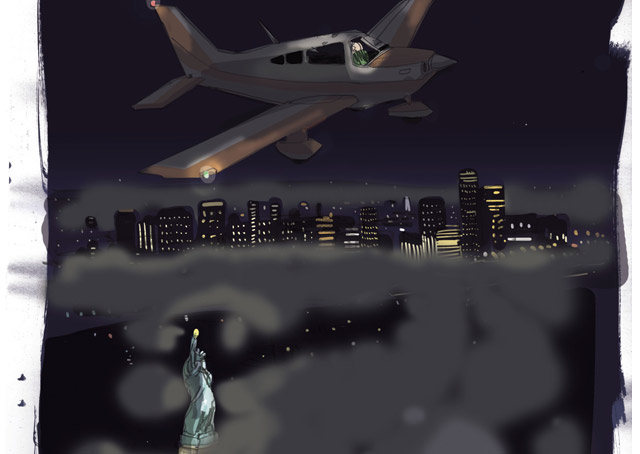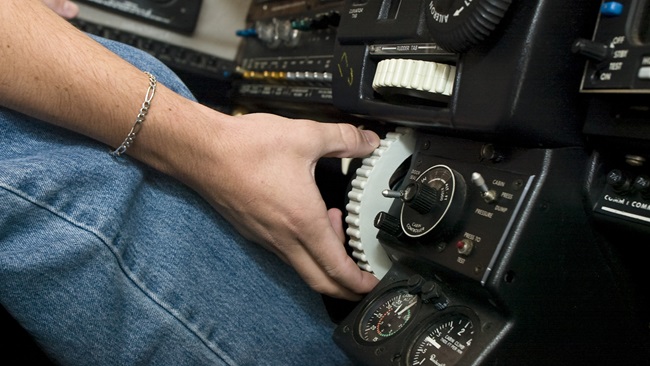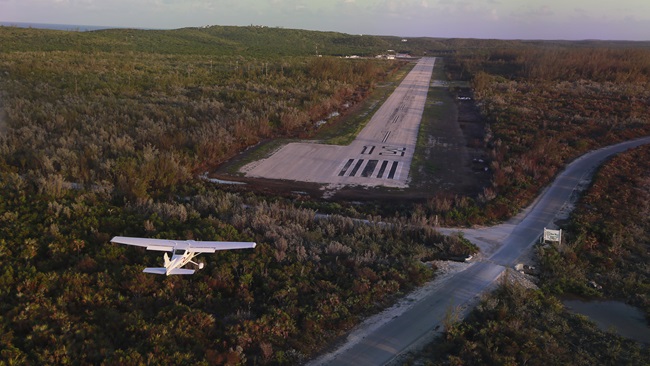In between is a place that doesn’t exist

IFR or VFR? I got a powerful reminder to choose one set of rules or the other when I came close to flying into a skyscraper.
A few summers back, I was returning to my home base of Somerset Airport (SMQ) in Somerset, New Jersey, from Martha’s Vineyard at night in my Piper Archer. The forecast was for visual conditions, but the weather was deteriorating from west to east. Good VFR weather was predicted for most of my route; the lowest forecast ceiling was near my destination—3,000 broken at Newark at my arrival time.
I filed a backup IFR flight plan for my VFR flight. The flight plan was bare-bones minimum: a direct course to my destination from the Solberg VOR, a distance of just four miles. I wanted only to ensure that I had “something in the system.”
The VFR flight from the Vineyard to the eastern border of the New York Class B airspace was uneventful. New York Approach Control cleared me to enter the Class B airspace direct LaGuardia at 2,000 feet. The LaGuardia tower controller directed me to descend to 1,500 feet, saying that he knew there were clouds at 2,000 feet near the airport.
Once past LaGuardia and over Manhattan, I flew into clouds at 1,500 feet. I told the LaGuardia controller that I was unable to maintain VFR and requested that he activate my IFR flight plan. He told me to climb to 2,000 feet.
Shortly after I crossed into New Jersey, the controller informed me that the next sector couldn’t accept me, and he directed me to descend southbound into the Class B VFR corridor (at that time, the airspace over the Hudson River below 1,100 feet). I saw a hole in the clouds and descended. Much to my chagrin, my altitude was only 500 feet when I finally reached the cloud bases.
As soon as the words were out of my mouth, I regretted reporting level at 500 feet, because I knew in advance what the controller’s response would be. The next thing I heard was “Frequency change approved. Maintain VFR.” I quickly told the controller that I couldn’t maintain VFR. To make the case as compellingly as I could, I pointed out that I was unable to see the Verrazano-Narrows Bridge that I knew to be only a few miles ahead. Awaiting a response, I drifted downward to avoid the cloud bases.
The controller instructed me to climb to 2,000 feet and to fly heading 040. I turned to 040 by circling the Statue of Liberty clockwise. When I rolled out of the turn, I was fortunate to be in probably the same hole in the clouds through which I had descended, and I was able to see the 781-foot-tall Goldman Sachs Tower on the New Jersey side of the river directly in my path. I altered course 20 degrees left to avoid flying into the tallest building in New Jersey and continued my climb to 2,000 feet. ATC never did find my flight plan. I filed another one with Flight Service en route and made it home after a long detour up the Hudson River.
All’s well that ends well, but I couldn’t help wondering how things might have turned out if I had been in the clouds after rolling out at 040. Would I have followed that vector into the building? Would I have told the controller that I was IMC and asked for different instructions? Would I have had the presence of mind to reflect on the fact that a southerly heading would have been a safer direction for the climb than my northeasterly one, because there are no tall buildings south of the Statue of Liberty?
Or would I have thought, I have no good options. I’m in the clouds, but I’ll probably be in the clouds no matter which direction I turn, so I might as well continue doing what I was assigned? Would I have stopped to consider in the heat of the moment that no controller ever expects to vector airplanes in clouds below 500 feet near high-rise buildings and that, of course, this controller expected me to be able to see where I was going?
It’s hard to know what I would have done, but I can see clearly in retrospect that there was a problem with my mindset. My brain had drifted to halfway between VFR and IFR—a place that doesn’t exist. I should have been thinking, I’m VFR, and I have to do whatever it takes to see where I’m going. If I can’t see where I’m going, I have to declare an emergency and fly a heading I know to be free of obstructions. Instead I was thinking, I have to get myself on an instrument flight plan, and this controller is going to get me on one.
Of course, a smarter pilot might have declined the descent into the Class B VFR corridor to begin with. But that’s a different subject.
Gregory Palermo is a retired pathologist who lives in Martha’s Vineyard, Massachusetts.
Digital Extra: Hear this and other original “Never Again” stories as podcasts every month on iTunes and download audio files free.


